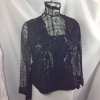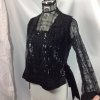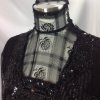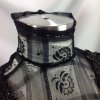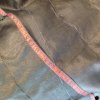Buygones13
Registered Guest
I am much more familiar with mid century clothing. We have a lovely little Assistance League that adores my husband. Months they tried to get him to take this Beldings Silk? Victorian? Blouse. They finally made him take it in a lot of clothing he purchased.
It is delicate with very little loss of beading. Delicate some torn fabric at neck. It appears that everything is hand sewn, all closure are hooks, side fastening. Neck has squiggly wire stays to keep up. Weighted in the back. it looks like it would have been over a skirt. A mourning blouse? Or did they all just like black back then?
I'm trying to figure out what era I truly have here. I am seeings all sorts of things on Etsy / Ebay that do not look nearly as magnificent as this one. Not something that should be worn but preserved.
Thank you for any and all information
It is delicate with very little loss of beading. Delicate some torn fabric at neck. It appears that everything is hand sewn, all closure are hooks, side fastening. Neck has squiggly wire stays to keep up. Weighted in the back. it looks like it would have been over a skirt. A mourning blouse? Or did they all just like black back then?
I'm trying to figure out what era I truly have here. I am seeings all sorts of things on Etsy / Ebay that do not look nearly as magnificent as this one. Not something that should be worn but preserved.
Thank you for any and all information
